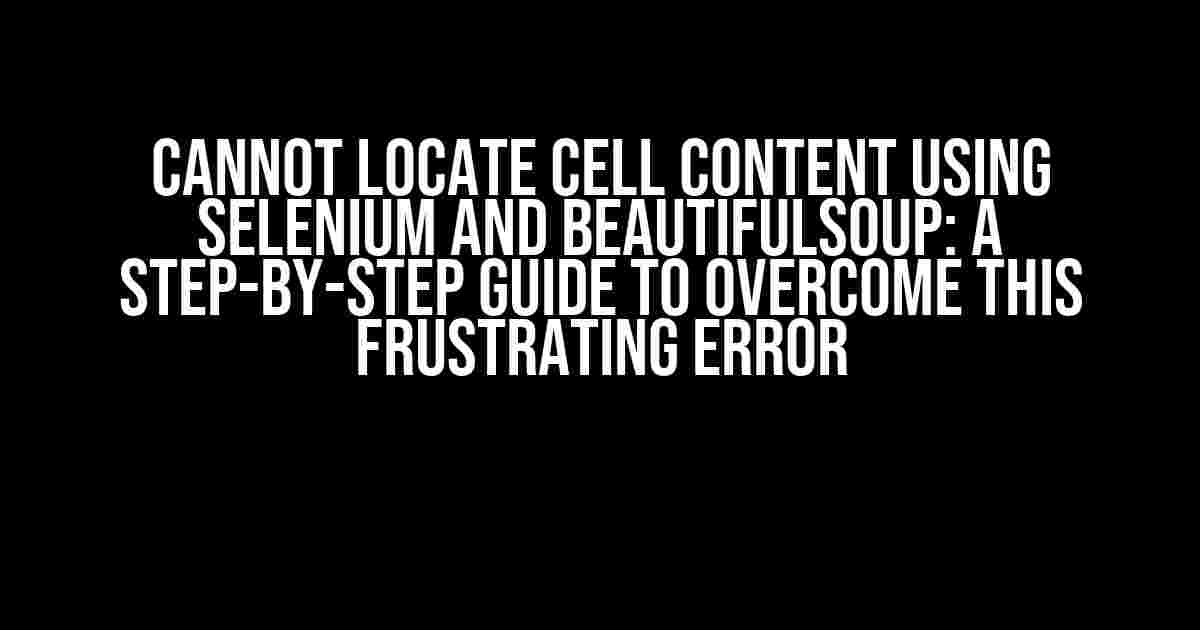Are you tired of encountering the “Cannot locate cell content using Selenium and BeautifulSoup” error while web scraping? Do you find yourself banging your head against the wall, wondering why your code isn’t working as expected? Fear not, dear scraper, for we have got you covered! In this comprehensive guide, we will walk you through the most common reasons behind this error and provide you with actionable solutions to overcome it.
Understanding the Error
Before we dive into the solutions, it’s essential to understand what’s causing this error. Selenium and BeautifulSoup are two powerful tools used for web scraping. Selenium is used to interact with dynamic web pages, while BeautifulSoup is used to parse HTML content. When Selenium is unable to locate cell content, it’s often because:
- The webpage is loaded dynamically, and Selenium hasn’t waited long enough for the content to load.
- The HTML structure of the webpage is complex, making it challenging for BeautifulSoup to parse.
- The website is using anti-scraping measures, such as CAPTCHAs or rate limiting.
Troubleshooting Steps
Now that we’ve identified the potential causes, let’s get started with the troubleshooting steps:
Step 1: Check the HTML Structure
Inspect the HTML structure of the webpage using the browser’s developer tools. Look for any unusual or complex HTML structures that might be causing the issue. You can use the “Elements” tab in Chrome or the “Inspector” tab in Firefox to inspect the HTML.
<table>
<tr>
<td>Cell 1</td>
<td>Cell 2</td>
</tr>
<tr>
<td>Cell 3</td>
<td>Cell 4</td>
</tr>
</table>
In the above example, the HTML structure is simple, and it’s easy to locate the cell content. However, in some cases, the HTML structure might be complex, making it challenging to locate the cell content.
Step 2: Use Selenium’s Wait Mechanism
Selenium provides various wait mechanisms to ensure that the webpage has loaded completely before attempting to locate elements. You can use the WebDriverWait class or the implicit_wait method to wait for the elements to load.
from selenium.webdriver.support.ui import WebDriverWait
from selenium.webdriver.common.by import By
from selenium.webdriver.support import expected_conditions as EC
driver = webdriver.Chrome()
driver.get("https://example.com")
# Wait for the table to load
table = WebDriverWait(driver, 10).until(
EC.presence_of_element_located((By.TAG_NAME, "table"))
)
# Get the cell content
cells = table.find_elements(By.TAG_NAME, "td")
for cell in cells:
print(cell.text)
In the above example, we’re using the WebDriverWait class to wait for the table to load. We’re specifying a timeout of 10 seconds, and if the table doesn’t load within that timeframe, Selenium will throw a TimeoutException.
Step 3: Handle Anti-Scraping Measures
Some websites employ anti-scraping measures, such as CAPTCHAs or rate limiting, to prevent bots from scraping their content. You can use services like 2captcha or captchasolver to handle CAPTCHAs, or use a proxy service like ScrapeOps to rotate your IP addresses and avoid rate limiting.
from selenium import webdriver
from captcha_solver import CaptchaSolver
driver = webdriver.Chrome()
driver.get("https://example.com")
# Solve the CAPTCHA
solver = CaptchaSolver("2captcha")
captcha_solution = solver.solve_captcha(driver.find_element(By.ID, "captcha"))
# Enter the CAPTCHA solution
driver.find_element(By.ID, "captcha_solution").send_keys(captcha_solution)
# Submit the form
driver.find_element(By.ID, "submit").click()
In the above example, we’re using the captcha_solver library to solve the CAPTCHA. Once we have the solution, we’re entering it into the form and submitting it.
Using BeautifulSoup to Parse HTML Content
Once you’ve handled the anti-scraping measures and Selenium has located the cell content, you can use BeautifulSoup to parse the HTML content.
from bs4 import BeautifulSoup
driver.get("https://example.com")
html = driver.page_source
soup = BeautifulSoup(html, "html.parser")
table = soup.find("table")
cells = table.find_all("td")
for cell in cells:
print(cell.text)
In the above example, we’re using BeautifulSoup to parse the HTML content. We’re finding the table element and then locating all the cell elements within it.
Common Scenarios and Solutions
Here are some common scenarios and solutions to help you overcome the “Cannot locate cell content using Selenium and BeautifulSoup” error:
| Scenario | Solution |
|---|---|
| Dynamic loading of content | Use Selenium’s wait mechanism to wait for the content to load. |
| Complex HTML structure | Use BeautifulSoup’s parsing features to navigate the HTML structure. |
| Anti-scraping measures | Use services like 2captcha or captchasolver to handle CAPTCHAs, or use a proxy service like ScrapeOps to rotate your IP addresses. |
| JavaScript-generated content | Use Selenium’s JavaScript execution feature to execute JavaScript and load the content. |
Conclusion
In this article, we’ve covered the most common reasons behind the “Cannot locate cell content using Selenium and BeautifulSoup” error and provided actionable solutions to overcome it. By following these steps and using the right tools, you should be able to scrape web pages with ease.
Remember, web scraping is a complex task, and it requires patience, persistence, and creativity. Don’t be discouraged if you encounter errors – instead, use them as an opportunity to learn and improve your skills.
Frequently Asked Question
Struggling to locate cell content using Selenium and BeautifulSoup? You’re not alone! Here are some frequently asked questions to help you troubleshoot the issue.
Why can’t I locate cell content using Selenium and BeautifulSoup, even when I can see it in the browser?
This might be due to the loading time of the webpage. Selenium and BeautifulSoup are fast, but sometimes the webpage takes time to load, and by the time it loads, the script has already executed. Try adding a delay or using WebDriverWait to ensure the page is fully loaded before scraping.
How do I handle JavaScript-generated content when using Selenium and BeautifulSoup?
Selenium can handle JavaScript-generated content, but BeautifulSoup can’t. Try using Selenium’s `get_attribute()` or `get_property()` methods to retrieve the content instead of relying on BeautifulSoup. You can also use `execute_script()` to execute a JavaScript script that retrieves the content for you.
Why does my script work in the browser but not when running with Selenium and BeautifulSoup?
This might be due to differences in the browser’s User Agent and the one used by Selenium. Some websites block requests from unknown User Agents. Try setting a valid User Agent using `options.add_argument(“–user-agent=
How do I handle pages that load content dynamically when scrolling down?
Use Selenium’s `execute_script()` to scroll the page down and then retrieve the content. You can also use a `while` loop to continuously scroll and retrieve content until no more new content is loaded.
Why do I get a `StaleElementReferenceException` when trying to locate cell content?
This exception occurs when the element you’re trying to locate is no longer present in the DOM. Try re-finding the element before trying to access its content. You can use `find_element_by_xpath()` or `find_element_by_css_selector()` to re-find the element.



